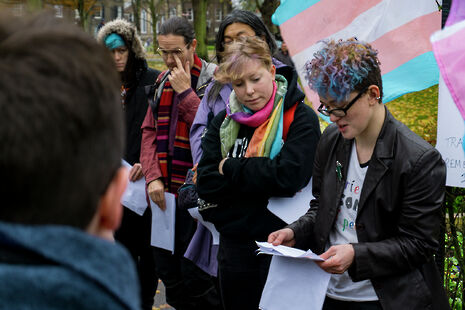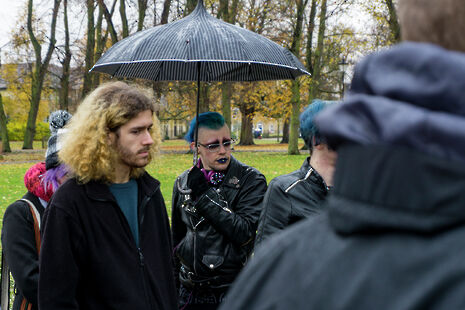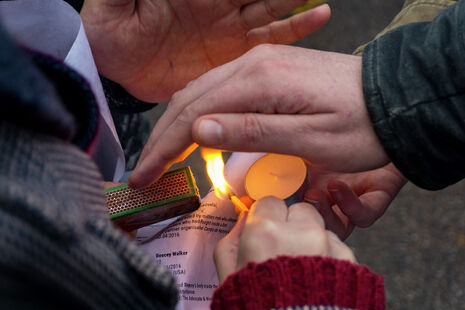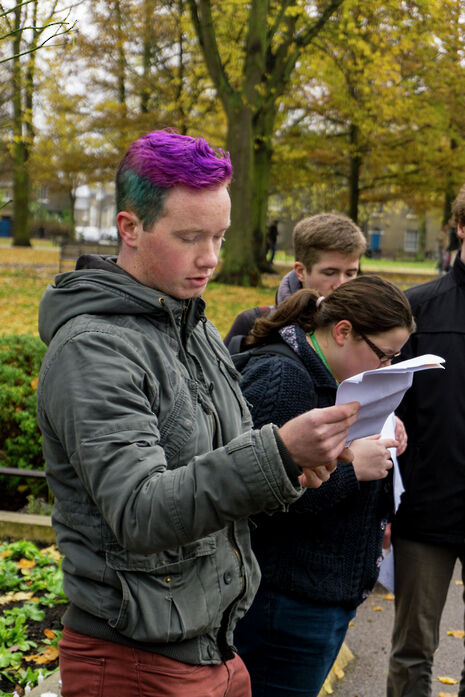‘We require you to stand up’ – students gather for Trans Day of Remembrance
After worst recorded year for violence against trans people, vigil-goers lit candles and read the names of the fallen at Christ’s Pieces

CHRIST’S PIECES – Most of the candles went out seconds after being lit – snuffed out by the endless drizzle and freezing wind.
Still, the vigil-goers attended to them, using lighters and matches to try and keep as many aflame as possible. As the candle-lighters moved around the edge of the Princess Diana Memorial Garden at Christ’s Pieces, more of the roughly 30 attendees stood at its centre, reading aloud the names of transgender people killed around the world in the last year.
It took nearly three quarters of an hour to read all the names. Many of the speakers had a few sheets of paper each, and as they went through the 54 pages of names, some spoke with a shiver in their voices.
The vigil this afternoon marked Trans Day of Remembrance (TDoR), which commemorates the lives of transgender and gender-diverse people, and raises awareness of violence against trans people worldwide.
October 2015 to the end of September 2016 saw the highest number of reported murders of transgender people worldwide in eight years
(Source: TMM)
The year from October 2015 to the end of September 2016 saw the highest number of reported murders of transgender people worldwide in eight years, according to the Trans Murder Monitoring (TMM) project.
Among them is Vikki Thompson, who died in a men’s prison at Armley, Leeds. Described by her solicitor as “essentially a woman”, she had repeatedly asked to be moved to a women’s prison. She was found unresponsive in her cell on a Friday evening last November, and her death was not treated as suspicious. Though an inquiry is ongoing, her name appeared among the 295 the vigil-goers read.
Thompson is an exception, in that so much is known about her case. For many of the names compiled by the project, information is minimal – many were identified simply as N.N. (no name). One such victim, whose age and cause of death were also unlisted, was found under a bridge in La Patilla, Venezuela, at the end of last year.

The TMM project’s limitations are clear, and acknowledged – it is biased not only towards countries where at least some expression of non-binary gender identities is acceptable, but also more distinctly towards countries with strong transgender communities, who can subsequently produce reliable reports. By far the largest number of reported deaths are from Brazil. Nonetheless, it highlights a very real problem.
The vigil on Christ’s Pieces was led by Aithghen Huskinson, a Veterinary Medicine student at St. Catharine’s College. Before the reading of the names began, I spoke to Huskinson about their experiences as a transgender student at Cambridge. They spoke of hardships – acknowledging that there are still strides to be made, but praising the general tolerance of the University community.
“Very few people misgender me at Cambridge”
“It’s not easy,” they told me. Huskinson described some parts of the University as still “very set in their ways”, and was concerned about bad experiences which many students have had with security at nightclubs – several of those at the vigil said told me they had either known people be harassed or thrown out of club toilets, or had experienced it themselves.
The general praise for the University was echoed by others I spoke to. Cici Carey-Stuart, a fresher studying Music at Corpus Christi, told me he had found his experience at Cambridge as a transgender student to be far easier than at home, where he “had to work to get people to acknowledge” that he is a man.
“Very few people misgender me at Cambridge,” he said, describing the support he had been offered at Corpus as “fantastic”.

Another attendee, Jamie Vincent, who studies Psychology at Anglia Ruskin University (ARU) and is part of its Transgender Visibility Campaign, told me his university too had been “very receptive” to discussions about rights for trans people.
The vigil-goers were a diverse group – a mixture of ages, ethnicities and appearances reflecting the range of backgrounds they came from: some from the University of Cambridge, others from ARU, and some from town groups. All were united by a shared question as the names – Vanessa, Paloma, Melanie – were read aloud: how do you come to terms with such hatred and intolerance towards a group you are part of? Some speakers seemed to be holding back tears. As the vigil reached its end, one held a pink, white and blue transgender pride flag, which was hanging from the monument, against her face.
After the names were read, with a few candles still burning despite the elements, Huskinson gave a speech, thanking all those who attended and imploring: “Please take care of yourselves”.

They also spoke out to cisgender (non-transgender) people: “We require you to stand up” – calling for their support in pushing for the legal recognition of non-binary people in UK law. Earlier this year, CUSU LGBT+ launched a campaign, ‘I Don’t Exist’, which called for options beyond male/female to be offered on government forms.
After Huskinson’s speech, I spoke to Blake Gutt, who is studying for a PhD in French at King’s. He described the vigil as “very moving”, and said it showed there is an “enormous way to go” yet before transgender people are treated equally. He said that there was still a “lack of understanding regarding what being trans is”, and that many students at Cambridge, though they “intend to be helpful”, cause offence in their attempts to accommodate transgender students.
A former student, Jake, said that though central elements of the University were receptive to the expansion of transgender rights, there was still progress to be made on the “college level”.
“We deserve better, and we will survive”
Jake said that the list of names “reminds you to pay attention” to worldwide persecution of trans people, and spoke of how hard it is, when presented with such a “horrendously large number” of names, to bear in mind the individuality of each of the victims listed.
Some people wrote messages on signs attached the the monument at the end of the vigil. Many were simple messages of solidarity, but one stood out: “My friend killed himself last month, making it now two trans friends that I have lost through suicide the last 3 years. We deserve better, and we will survive.”
It is easy, in a place as generally liberal and tolerant as Cambridge, to neglect the struggles faced by LGBT+ students – the event highlighted just how far rights and recognition here are ahead of many places in the world. Yet as the attendees spoke aloud the names of people persecuted for their very identities – people just like them – it was impossible to ignore not only the incredible importance of their solidarity, but also how much the movement needs the support of those beyond it.
 Features / Should I stay or should I go? Cambridge students and alumni reflect on how their memories stay with them15 December 2025
Features / Should I stay or should I go? Cambridge students and alumni reflect on how their memories stay with them15 December 2025 News / Cambridge study finds students learn better with notes than AI13 December 2025
News / Cambridge study finds students learn better with notes than AI13 December 2025 News / Uni Scout and Guide Club affirms trans inclusion 12 December 2025
News / Uni Scout and Guide Club affirms trans inclusion 12 December 2025 Comment / The magic of an eight-week term15 December 2025
Comment / The magic of an eight-week term15 December 2025 News / News In Brief: Michaelmas marriages, monogamous mammals, and messaging manipulation15 December 2025
News / News In Brief: Michaelmas marriages, monogamous mammals, and messaging manipulation15 December 2025










